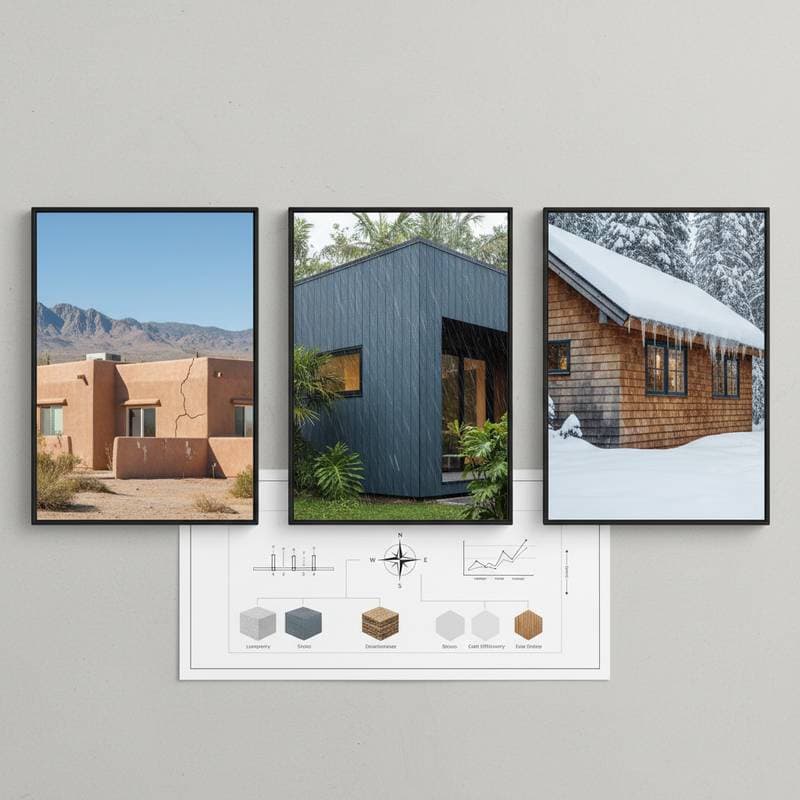Why Climate Influences Siding Selection
Selecting siding extends beyond aesthetics. Local climate governs material resilience, maintenance frequency, and protective efficacy. Diverse zones, such as coastal humidity or inland aridity, impose unique stresses on exteriors. Thoughtful selection harmonizes initial expense, endurance, and market appeal while ensuring foreseeable upkeep.
This resource delineates climate impacts on siding efficacy, highlights regionally superior materials, and outlines installation plus maintenance protocols that safeguard enduring worth.
Siding Materials and Profiles
Various siding variants respond distinctly to thermal extremes, freeze-thaw cycles, or corrosive atmospheres. Climate-informed choices avert issues like thermal expansion fissures, surface delamination, and moisture retention.
| Material | Pros | Cons | Maintenance Need | Fire & Moisture Resistance |
|---|---|---|---|---|
| Vinyl | Affordable pricing, extensive color options, minimal weight | Susceptible to brittleness in subzero temperatures, prone to deformation under intense solar exposure | Annual surface cleaning with mild detergent | Moderate fire resistance, adequate moisture handling |
| Fiber Cement | Exceptional dimensional stability, impervious to flames and decay | Substantial heft, periodic recoating required | Visual inspections biennially, recoating every decade to fifteen years | Superior fire protection, robust moisture deflection |
| Engineered Wood | Authentic aesthetic, reduced mass compared to fiber cement | Demands meticulous sealing at fabrication edges | Recoating or resealing at eight- to ten-year intervals | Solid fire performance, fair moisture management |
| Metal (Steel or Aluminum) | Robust construction, minimal ongoing care | Vulnerable to impacts causing deformations, elevated costs for ancillary components | Biannual rinsing to remove particulates | Outstanding fire resistance, effective moisture barrier |
| Natural Wood | Timeless visual charm | Intensive preservation, susceptible to insect infestation | Refinishing at three- to five-year cycles | Limited fire tolerance, minimal moisture protection |
Profile Integration Strategies:
Apply sleek panels across expansive surfaces and reserve embossed elements for delineating portals or apexes. Restricting variegation minimizes optical disarray and facilitates seamless tonal shifts in visual documentation.
Key Insight: Arid or fire-vulnerable locales favor fiber cement or metallic options. Humid territories benefit from vinyl or engineered composites to mitigate decomposition hazards. Consistently seal exposed edges and establish unobstructed runoff channels.
Installation Precision and Hazard Mitigation
Superior materials falter under subpar application. Climate dictates wall assembly dynamics for vapor and airflow regulation.
Building Envelope Safeguards:
Position uninterrupted moisture shields beneath all cladding. Secure junctions with adhesive tape and integrate flashing at apertures, portals, and fixtures. In precipitation-heavy regions, incorporate an air-circulating rainscreen cavity to inhibit condensation-induced deterioration. For instance, maintain a one-quarter-inch separation using furring strips to promote drying.
Frequent Vulnerability Sites:
- Unsecured overlaps at abutments.
- Absent rear flashing beneath linear accents.
- Overdriven fasteners restricting material movement.
- Omitted diverter flashing at roof-wall intersections.
Mitigation Protocols:
- Time operations during favorable dry spells to allow sealants and adhesives to set adequately.
- Enclose work zones to shield adjacent vegetation and neighboring grounds from detritus.
- Examine underlying sheathing prior to concealment; substitute any compromised or delaminated sections.
- Mandate photographic documentation of concealed assemblies for archival and assurance validation.
Key Insight: Rigorous oversight upholds guarantees and averts remedial interventions. Pristine sites and methodical progression curtail enduring infiltration perils.
Choosing and Evaluating Contractors
Competent applicators guarantee climate-suited groundwork and refinements. Solicit proposals encompassing equivalent project parameters for equitable assessment.
Project Specification Inventory:
- Precise material designation and gauge
- Substrate barriers and permeability layers
- Accessory and sealant particulars
- Demolition plus waste handling of prior exteriors
- Regulatory compliance and refuse oversight
Proposal Evaluation Approach:
Obtain no fewer than three formal quotations. Verify uniformity in coverage area, thermal layers, and ornamental configurations. Inquire about attachment methods and intervals, as these influence certification eligibility. For example, specify corrosion-resistant fasteners spaced sixteen inches on center for optimal hold.
Compensation Phasing:
Tie disbursements to verifiable progressions rather than timelines. A balanced allocation includes thirty percent upon supply arrival, forty percent following facade enclosure, and thirty percent post comprehensive review.
Key Insight: Comprehensive outlines forestall conflicts. Reputable specialists embrace inquiries regarding impermeability and efflux mechanisms.
Sustaining Siding Performance Over Time
Well-chosen siding operates unobtrusively, upholding thermal regulation and asset appreciation. Aligning selections with regional conditions thwarts accelerated wear and extravagant restorations. In moisture-laden districts, prioritize impermeable compositions and airflow provisions. Arid, sun-baked expanses demand UV-stable hues and flexible substrates. Frigid territories necessitate thermal retention and resilience to frozen projectiles or granular assaults.
Long-term, regionally attuned exteriors diminish expenditures on climate control and remediation. Such selections preserve visual integrity, standardize care routines, and convey craftsmanship to prospective acquirers.

